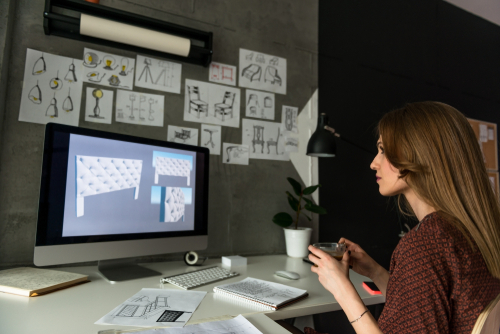What is the Design Process Like for a Graphic Designer?
In addition to learning various techniques for the creation of projects, completing a degree program with accreditation provides graphic designers with the training needed to implement a process to successfully complete designs. With a well-developed process, graphic designers can help clients fulfill the goals of each project.
Consultation and Pre-design
Whether designing packaging to sell a product, a print advertisement to attract a customer, or anything in between, graphic designers work through a system to meet every individual client’s needs. At the start of a creative project, understanding the entire scope of the client’s needs and expectations is essential. To begin the design process, graphic designers will meet with clients, in person or via another medium of communication such as phone or video conference. Clients and designers are able to outline the entire scope of the project.
During the initial meeting or after its completion, designers often move forward to the brainstorming process. Brainstorming often includes researching to fully understand a client, a type of project, or a specific requirement. Next, designers will sketch, storyboard, or create a word outline. This phase enables a designer to begin to organize ideas and choose a final design focus, including dimensions, colors, and typography, as well as to ensure that the visions generated moving forward are original and not too close to a competitor’s previous ideas. “Idea Generation among Creative Professionals” in the Creative Research Journal includes additional methods and discussion for the importance of idea generation and the implementation of other pre-design steps of the graphic design process.
Creation
Once the project direction has been determined, graphic designers move on to the creation of the project. Using various tools, such as Adobe InDesign, a design professional is able to create mock-ups of the proposed piece. Sharing mock-ups with a client and reviewing at this phase in the process helps to save time and ensure that clients are satisfied with the direction of the design.
Completing the final design or designs also includes creating the piece in the proper format. The project might need to be completed in a print-ready file for print publication, for example, or as a JPEG for inclusion on a website. During the creation phase, designers should also take steps to ensure that specifications for production are taken into consideration.
Project Finalization
The completion of a design project requires feedback from a client. Graphic designers present final options of a project in order for a client to request any alterations. Changes are then incorporated and sent to a client for final approval. Once the design has been accepted by a client, the designer is able to send the completed piece forward to production or directly to the client. Including any specific directions for production, particularly if the piece is going to the client, will be necessary in this part of the process as well.
From the start of a design project to the production of the finished piece, several steps are necessary. Design degree and training programs that have full accreditation provide future graphic designers with the knowledge to develop a system for pre-design, creation, and finalization of all types of projects that works best for them to work effectively with clients.
Related Resources:
